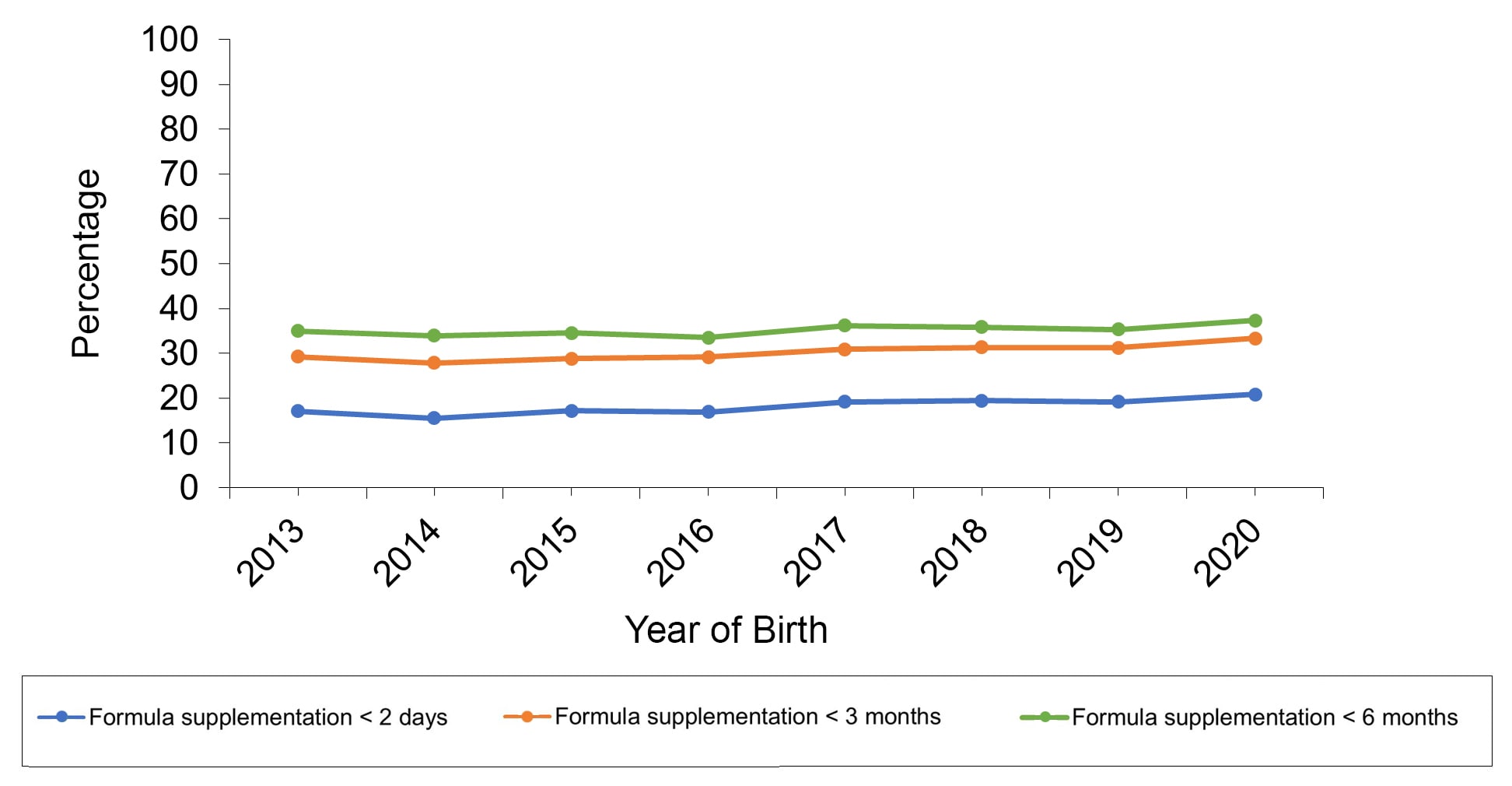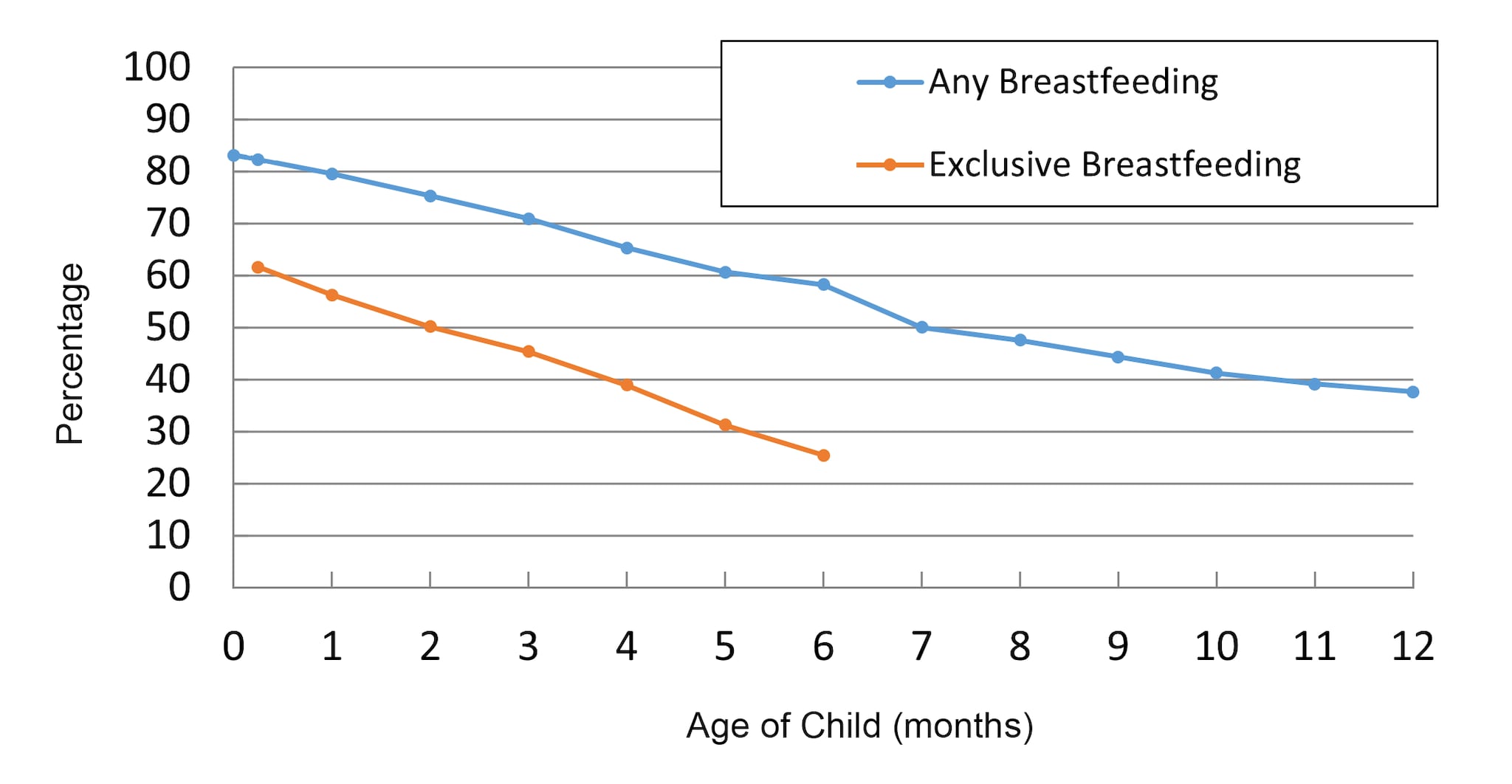Results: Breastfeeding Rates
National Immunization Survey - Child (NIS-Child)
Breastfeeding Among U.S. Children Born 2013-2020, CDC National Immunization Survey-Child
Percentage of U.S. Children Who Were Breastfed, by Birth Year1,2,3
Any Breastfeeding
Exclusive Breastfeeding
Percentage of U.S. Children Who Were Breastfed, by Birth Year, National Immunization Survey-Child, United States (Percentage ± half 95% Confidence Interval)1,2, 3
| Birth Year | ||||||||
|---|---|---|---|---|---|---|---|---|
| 2013 | 2014 | 2015 | 2016 | 2017 | 2018 | 2019 | 2020 | |
| Ever Breastfed | 81.1±1.1 | 82.5±1.1 | 83.2±1.0 | 83.8±1.2 | 84.1±1.0 | 83.9±0.9 | 83.2±1.0 | 83.1±1.0 |
| At 6 months | 51.8±1.4 | 55.3±1.4 | 57.6±1.4 | 57.3±1.6 | 58.3±1.4 | 56.7±1.2 | 55.8±1.3 | 58.2±1.2 |
| At 12 months | 30.7±1.3 | 33.7±1.3 | 35.9±1.3 | 36.2±1.5 | 35.3±1.4 | 35.0±1.1 | 35.9±1.2 | 37.6±1.2 |
| Exclusively through 3 months | 44.4±1.4 | 46.6±1.4 | 46.9±1.4 | 47.5±1.6 | 46.9±1.4 | 46.3±1.2 | 45.3±1.3 | 45.3±1.2 |
| Exclusively through 6 months | 22.3±1.1 | 24.9±1.3 | 24.9±1.2 | 25.4±1.3 | 25.6±1.2 | 25.8±1.0 | 24.9±1.1 | 25.4±1.1 |
- Data from 2013 to 2015 births were based on landline and cellular telephone sampling, and data for 2016 births and onward were based on cellular telephone sampling only. See Survey Methods for details and data prior to 2013 at Data, Trends, and Maps.
- Data from US territories are excluded from national breastfeeding estimates to be consistent with the analytical methods for the establishment of Healthy People 2030 targets on breastfeeding.
- Exclusive breastfeeding is defined as ONLY breast milk — NO solids, water, or other liquids.
Breastfeeding Rates by State and Sociodemographics Characteristics1
| “Any” and “Exclusive” Breastfeeding Rates | Birth Year |
|---|---|
| -by State | 2020 |
| -by Sociodemographics | 2020 |
1To access previous breastfeeding rates by state and sociodemographics, visit Data, Trends, and Maps
Percentage of Breastfed Children Who Were Supplemented with Infant Formula, by Birth Year, National Immunization Survey-Child, United States1,2,3

Percentage of U.S. Breastfed Infants Who Were Supplemented with Infant Formula, by Birth Year, National Immunization Survey-Child, United States (Percentage +/- half 95% Confidence Interval)1,2,3
| Birth Year | ||||||||
|---|---|---|---|---|---|---|---|---|
| 2013 | 2014 | 2015 | 2016 | 2017 | 2018 | 2019 | 2020 | |
| Before 2 days | 17.1±1.2 | 15.5±1.0 | 17.2±1.2 | 16.9±1.3 | 19.2±1.3 | 19.4±1.2 | 19.2±1.1 | 20.8±1.1 |
| Before 3 months | 29.2±1.6 | 27.8±1.5 | 28.8±1.5 | 29.1±1.7 | 30.9±1.6 | 31.3±1.4 | 31.2±1.4 | 33.3±1.4 |
| Before 6 months | 34.9±1.8 | 33.8±1.7 | 34.5±1.7 | 33.5±1.9 | 36.2±1.8 | 35.8±1.5 | 35.3±1.5 | 37.3±1.5 |
- Data from 2013 to 2015 births were based on landline and cellular telephone sampling, and data for 2016 births and onward were based on cellular telephone sampling only. See Survey Methods for details and data prior to 2013 at Data, Trends, and Maps.
- Data from US territories are excluded from national breastfeeding estimates to be consistent with the analytical methods for the establishment of Healthy People 2030 targets on breastfeeding.
- Formula supplementation is defined as supplementation of breast milk with formula (with or without other supplementary liquids or solids) among infants breastfed before the age specified (2 days, 3 months, or 6 months). See Survey Methods for details.
Rates of Any and Exclusive Breastfeeding by Age Among Children Born in 2020, National Immunization Survey-Child, United States1,2,3

Rates of Any and Exclusive Breastfeeding by Age Among Children Born in 2020 (Percentage +/- half 95% Confidence Interval)1,2
| US National Breastfeeding Rates, 2020 Births | ||
|---|---|---|
| Child Age | Breastfeeding (n=21,069) |
Exclusive Breastfeeding3 (n=20,380) |
| At birth | 83.1±1.0 | |
| 7 days | 82.3±1.0 | 61.6±1.2 |
| 14 days | 81.7±1.0 | 59.1±1.2 |
| 21 days | 80.5±1.0 | 57.1±1.2 |
| 28 days | 79.8±1.0 | 56.6±1.2 |
| 1 month | 79.5±1.0 | 56.2±1.2 |
| 2 months | 75.3±1.1 | 50.1±1.2 |
| 3 months | 70.9±1.1 | 45.3±1.2 |
| 4 months | 65.3±1.2 | 38.9±1.2 |
| 5 months | 60.6±1.2 | 31.2±1.1 |
| 6 months | 58.2±1.2 | 25.4±1.1 |
| 7 months | 50.0±1.2 | |
| 8 months | 47.5±1.2 | |
| 9 months | 44.3±1.2 | |
| 10 months | 41.2±1.2 | |
| 11 months | 39.1±1.2 | |
| 12 months | 37.6±1.2 | |
| 18 months | 17.3±0.9 | |
1Data from US territories are excluded from national breastfeeding estimates to be consistent with the analytical methods for the establishment of Healthy People 2030 targets on breastfeeding.
2Exclusive breastfeeding is defined as ONLY breast milk—NO solids, water, or other liquids.
3The data point for exclusive breastfeeding begins at 7 days of life.
